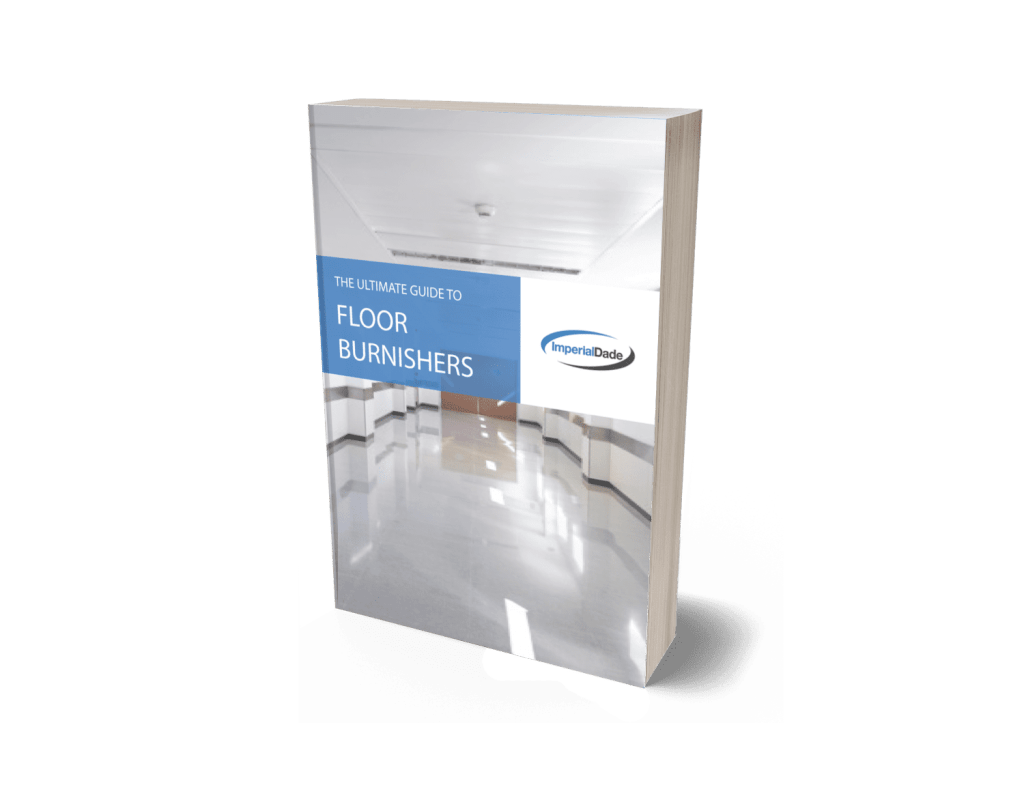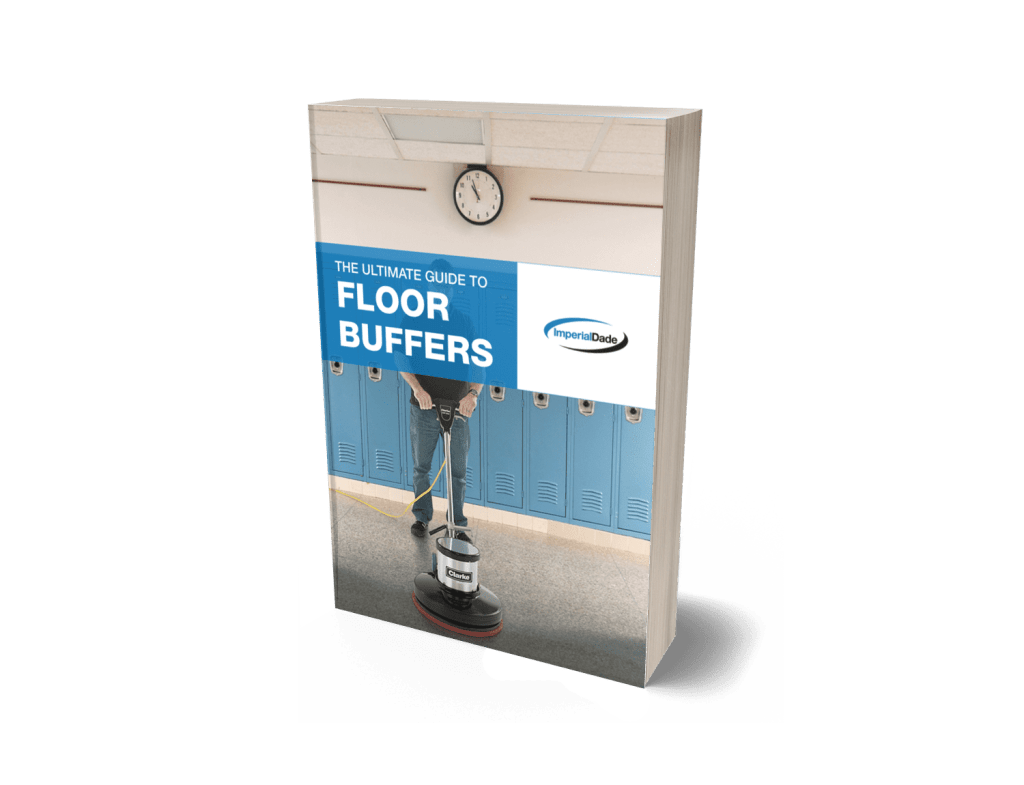Buffing and burnishing are two periodic procedures for cleaning and maintaining your facility’s hard floors. When used properly, both buffing and burnishing will help keep your hard floors looking great while making the job easier, taking less time, and saving money on labor.
Are Buffers and Burnishers the Same?
Buffers and burnishers are not the same piece of janitorial cleaning equipment.
Buffers and burnishers perform different tasks, and it is important to use the proper machine for the right job. Using the wrong machine to perform a selected cleaning procedure can cause damage to your floor and equipment.
What is the Difference Between a Buffer and a Burnisher?
The differences between a buffer and a burnisher are the speed, motion, and floor maintenance procedures they complete.
| BUFFERS: | BURNISHERS: |
| Are low speed | Are high speed |
| Operate in a side-to-side motion | Drive straight |
| Used to strip, clean, buff, or scrub a floor | Used to polish (burnish) a floor |
How Do I Know if I Need a Buffer or a Burnisher?
The key to choosing the right machine is understanding what task you are trying to complete.
Are you trying to strip the floor? Then you’re going to be looking for a buffer.
Are you looking for the best and most efficient way to restore a floor’s shine? Then you’re looking for a burnisher.
What is a Floor Buffer?
A floor buffer is a piece of industrial cleaning equipment that allows cleaning professionals to strip or remove the wax from a facility’s floor.
Buffers are commonly referred to as strippers, swing machines, or side-to-side machines.
Depending on the floor pad applied to the machine, buffers can also be used to buff, clean, or scrub your facility’s floor to remove dirt and scuff marks, restoring its original shine.
Buffers operate at low speeds of 175 – 300 RPM to perform a particular cleaning procedure.
A buffer rests directly on the pad, creating 100% contact between the floor and the pad. The machine does not rest on the hind wheels and the wheels should only be used for transport.
To maneuver, the operator is in full control as it moves side-to-side, hence the nickname “side-to-side” machine.
Read More: The 2 Best Commercial Floor Buffers Of 2022
Types of Buffers
Buffers can achieve different results depending on the type of gearbox and horsepower motor they have.
Power Source
All buffers are basic cord-electric models. Cord-electric buffers are plugged into a facility’s power outlet to operate. The power cord will need to be moved and re plugged as the cleaning path progresses.
Electric cords are typically 50 to 75 feet long.
Gearbox
The gearbox provides power and stability to rotate the floor pad in a balanced motion.
Gearboxes are available in three different types: single, double, and triple planetary.
Single and Double planetary gearboxes do not fully balance the power across the pad driver.
Triple planetary gearboxes provide the best torque and balance control.
Motor
Motors can range from .5 – 1.5 horsepower.
The higher the horsepower, the more power the machine will have to rotate the floor pad.
Most buffers have a 1.5 hp motor.
Motor size will depend on the machine size and facility budget.
Size
Buffers typically offer cleaning paths between 13 inches and 20 inches.
The most common size buffer is 20 inches.
The size you will need will depend on your facility type, size, and budget.
What is a Floor Burnisher?
A floor burnisher is a piece of power equipment used to polish or burnish a floor to bring out its original shine.
Burnishers operate at high speeds, 1000 – 3000 RPM, to achieve a high gloss shine within a few passes, rather than multiple passes with a buffer.
Burnishers rest on the wheels of the machine, driving the machine straight.
On most machines about 50% of the pad to touches the floor, but some advanced models offer better pad-to-floor contact.
Pro Tip: The success of each machine is dependent on selecting the right floor pad.
Read More: What is the Best Floor Pad for your Buffer or Burnisher?
Everything you need to know about commercial floor burnishers including types, sizes, specs, & more!

Types of Burnishers
Burnishers are available in traditional, entry-level (basic) models or advanced models.
Each type of burnisher can achieve different results depending on power and pressure output. Machine power and pressure are reliant on the power source.
Basic Burnishers
Basic Features
Size
The most common size cleaning path for a basic burnisher is 20 inches.
Power Source
Basic model burnishers are cord-electric.
Cord-Electric
The cord-electric burnisher is the most commonly purchased because of its low cost.
Cord-electric burnishers produce the least amount of downward pressure when compared to battery or propane powered machines because of the restricted power output allowed from a facility’s electrical outlets.
Electric cords are typically 50 to 75 feet long.
While the electric model is the lowest cost, having to stop, move the cord, and plug into another outlet can lead to decreased productivity.
Advanced Burnishers
Advanced Features
Advanced models are more expensive, but offer additional features like automatic height adjustment, dust control, and noise control.
Size
Advanced burnishers offer a larger range of cleaning paths from 12 to 35 inches.
Automatic Height Adjustment/Pad Pressure
When selecting a burnisher, keep in mind how the machine operates. Traditional burnishers will require you to manually adjust the pad to produce the correct amount of pressure on the floor. Machines that require manual adjustments allow for operator error, increased mistakes, and damage to your floor.
Pro Tip: More pad pressure does not mean more shine. Adjusting the pad pressure to create more downward pressure is not best practice. It can cause damage to your facility’s floor and shorten the useful life of your machine.
When possible, select a burnisher which has gas shocks that automatically adjust and balance the pad pressure of the machine to your floor.
Dust Control
Dust control aids in the removal of dust particles that were generated during the polishing process to improve indoor air quality and reduce the need for follow-up dust mopping.
Dust control machines are considered more environmentally friendly because they remove dust from the floor and draw it into an internal bag where the dust is contained. If you are using your dust control burnisher for daily maintenance, the dust control bag should be changed at least once a week.
Noise Control
Machines with low decibel output can be used for maintenance during regular business hours without disturbing occupants.
Power Source
More advanced burnishers are typically propane or battery powered. Some cord-electric models may offer some advanced features.
Propane and battery operated burnishers can increase productivity up to 30% when compared to cord-electric burnishers.
Battery-Powered
Battery powered burnishers offer increased portability, power, and productivity as a result of their cordless design.
Battery-powered burnishers can be walk-behind or ride-on.
Walk-Behind
Battery operated walk-behind burnishers are operated the same way electric or propane machines would be.
Ride-On
Ride-on burnishers perform the same tasks as traditional burnishers but allow the operator to sit on the machine and maneuver the machine with hand controls. They are practical for areas larger than 2,000 square feet where smaller burnishers would be inefficient.
Battery powered machines have a limited charge before they run out of power, so ensure that the machine is fully charged and able to accommodate the size area you are maintaining.
On a single charge, battery operated machines run for an average of 3 hours but vary by model and manufacturer.
Propane
Propane operated burnishers offer the greatest speeds and power.
To operate, they often require a plug-in starter or battery to start the motor.
Propane machines operate using an internal combustion motor which can pose safety concerns.
The propane motors can release toxic emissions and produce an unpleasant odor which can be harmful to occupants. Propane operated burnishers should only be used in well-ventilated areas.
Propane is extremely flammable and should be used with caution to avoid a fire hazard.
On average, a 20-pound or 5-gallon tank will operate for about 18-22 hours.
Final Thoughts
Adding commercial floor buffers and burnishers into your maintenance routine will help reduce cleaning times and lower labor costs.
If you’re located in the United States, Puerto Rico, or the Caribbean, EImperial Dade can match you with the best floor maintenance equipment to meet your facility’s needs, budget, and demands.
Contact an Imperial Dade Specialist today for a comprehensive review of your floor maintenance program. Our Specialists can help you identify the best floor machine to keep your floors looking their best.
Check Out These Additional Resources:
- The 2 Best Commercial Floor Buffers Of 2023
- Your Guide To The 5 Best Floor Burnishers of 2023
- How Much Does A Floor Buffer Cost? 6 Factors That Influence Price
- How Much Does a Floor Burnisher Cost?
- What Is The Best Floor Pad For Your Buffer or Burnisher [Video]?
- Top 4 Most Common Floor Buffer Problems
- How to Repair the Most Common Floor Burnisher Issues [VIDEO]
![What is the Difference Between Floor Buffers and Burnishers? [VIDEO]](https://imperialdade.blog/wp-content/uploads/2019/04/Herojpg-1-1024x402.jpg)
